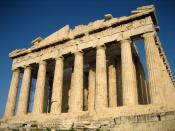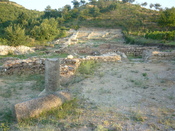When going from the Ancient Greek art period to the Byzantine art period you notice some definite changes in the style, and also the focal points in the art that is being created. In this stylistic analysis I am going to point out some of these major changes and try to explain why some of these changes occurred.
The first change I will point out is the art medium. The Ancient Greeks had been carving statues out of stone and building huge architectural structures out of rock. But when you get into the Byzantine art period one type of medium is the most popular. That is mosaic art works. Most of the mosaic art done during the Byzantine period was mural type wall, ceiling, and floor decorations done in churches and cathedrals.
Mosaic art works are "images made from pieces by small colored stone or glass pieces, affixed to a hard, stable surface" (Stokstad Glossary, 9).
Another noticeable change in Byzantine art is the subject matter. The subject matter change has a lot to do with the fact that the religions changed. The Ancient Greeks had worshipped many different Gods, and each God or Goddess was responsible for a different earthly or emotional element. But as we move into the Byzantine period the Christian religion is being adopted by the Greeks and Romans. Meaning instead of the worship of many God's there is only the worship of one. So now the art focus goes from Greek Gods and Goddesses to God, Jesus Christ and all the stories relating to the Christian religion.
Also with the Greeks and their art a huge emphasis was put on humanism and the perfection of the human form. In Ancient Greece outer beauty and perfection was very important. In Byzantine art the importance changes more...


